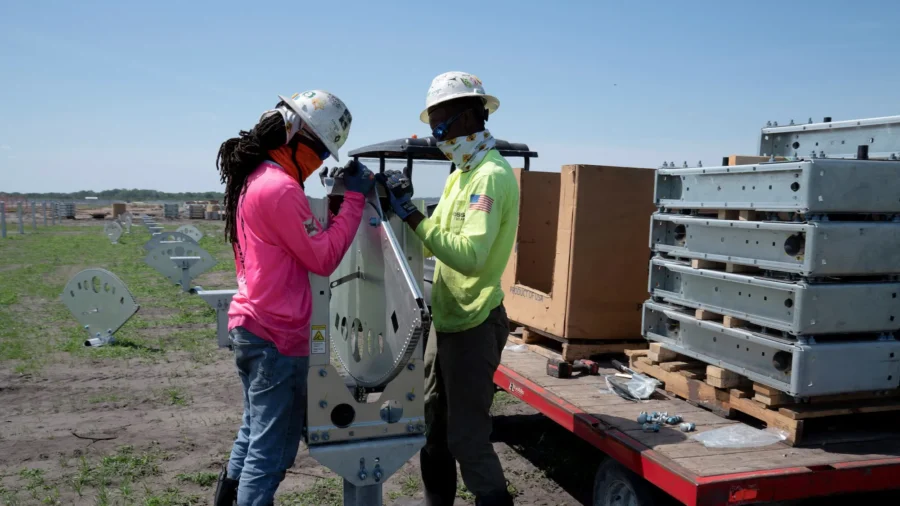In a bid to make clean energy jobs more attractive, the Biden administration is boosting some green energy project subsidies fivefold, provided their workers are paid higher wages.
The White House said on June 18 that the new rules implement provisions of the Inflation Reduction Act (IRA), under which companies that pay prevailing wages to workers and hire apprentices for projects seeking IRA tax credits would receive five times the normal base credit of 6 percent.
Known as prevailing wage and registered apprenticeship requirements, the new rules are part of President Joe Biden’s pledge that jobs created as part of his administration’s fight against climate change—such as building wind farms, constructing carbon capture facilities, and installing solar panels—will be good-paying and competitive with those in oil and gas.
The IRA provides roughly $370 billion in subsidies for green energy projects including solar, wind, and electric vehicles.
Part of what is driving the adoption of the new rules is that most of the IRA clean energy projects are located in counties with below-average median household incomes.
“The IRA’s investments are already creating jobs and lowering energy costs in communities that have long been held back by lack of investment, and these rules will help ensure that workers can continue to benefit from the clean energy transition,” Deputy Treasury Secretary Wally Adeyemo and Acting Assistant Secretary of Labor Julie Su wrote in a joint blog post.
A critic of the subsidy boost, says it’s unfair to give taxpayer-funded preferential treatment to workers in certain industries.
“Jobs in the fuel refining, petrochemical, and midstream energy industries—many of them union jobs—are high-paying and family-supporting. They are not easily matched or replaced,” Chet Thompson, president and CEO of American Fuel & Petrochemical Manufacturers (AFPM), told The Epoch Times in an emailed statement.
“Rather than funneling taxpayer dollars to inflate the value of his preferred jobs, the President should stop his regulatory assault on the future of America’s oil, gas, and petrochemical industry workers, and the millions of other Americans whose jobs are supported by these industries,” he said.
Subsidy Requirements
To qualify for the 500 percent greater subsidy, companies executing green energy projects will have to meet a number of requirements.
Key among these conditions is to ensure that all laborers and mechanics that they employ (or that are employed by any contractor or subcontractor) on the construction, alteration, or repair of a qualifying facility, such as a wind farm, are paid wages that are not lower than the prevailing rates determined by the Department of Labor in accordance with subchapter IV of chapter 31 of title 40 of the U.S. Code (the Davis-Bacon Act) for a similar type of job in the same geographical area.
There are limited exceptions where companies on green energy projects can still claim the 5-times higher incentive without meeting the prevailing wage and registered apprenticeship requirements, namely if the project is a small facility that produces clean energy under 1 megawatt and for facilities that began construction before Jan. 29, 2023.
The Department of Labor (DOL) recently launched a map estimating the number of workers at each “green” project that stand to benefit if companies carrying the projects meet the prevailing wage and apprenticeship requirements.
More Details
The White House said in the June 18 announcement that it is also encouraging companies to adopt project labor agreements (PLA), or pre-hire collective bargaining agreements, that set wage and employment terms between trade unions and contractors for specific green energy projects.
Unions are one of President Biden’s key constituencies as he seeks a second term in office.
Besides offering a fivefold greater subsidy for green projects, the new rules also waive IRS penalties for companies carrying out such projects if they have project labor agreements in place but are found by tax auditors to have broken certain rules.
“The final rules provide that taxpayers with qualifying PLAs in place will not have to pay penalties if the IRS finds that they have any prevailing wage and registered apprenticeship violations, as long as they promptly pay workers the back wages and interest that those workers are owed,” Mr. Adeyemo and Ms. Su wrote in their joint blog post.
“Additionally, the IRS will take into account whether a taxpayer has a qualifying PLA—and evidence, including statements from counterparties, of whether a qualifying PLA was complied with—when conducting audits,” they added.
The promise of lighter touch tax enforcement to incentivize the adoption of project labor agreements could be significant, given that the IRS has said that ensuring that companies claiming the increased tax credit have met all relevant requirements is a “top priority” for the agency.
“In the months ahead, the IRS will dedicate significant resources to promoting and enforcing compliance with the final clean energy rules,” the IRS said in a statement.
From The Epoch Times


